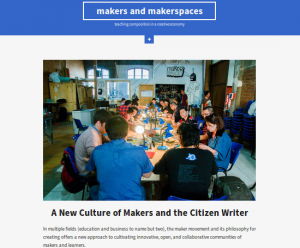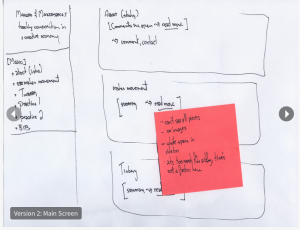Text: “Makers and Makerspaces: Teaching Composition in a Creative Economy”
Author: Jacob Craig
Publisher: Pearson Higher Education
Publication Date: August 2014

This month, the DRC fellows are interested in talking about multimodality. We’ve gotten the ball rolling on this conversation by issuing a Call for Blog Carnival Proposals titled “Beyond a ‘Single Language/Single Modality’ Approach to Writing.” To supplement the theme, and for my first official post on behalf of the DRC fellows, I’ve selected this month’s featured webtext, “Makers and Makerspaces” to provide another port of entry for the conversation. Though not directly related to multilingualism, this webtext felt like a natural fit for that conversation, as it works to develop new frameworks for approaching and facilitating multimodal composition, and provides an interesting model for what such scholarship might look like.
All-in-all, this text is user-friendly, easy to navigate, and provides a variety of user experiences, working with images, video, and even space (a la Prezi) to merge makerculture and composition.
Jacob Craig‘s webtext, “Makers and Makerspaces: Teaching Composition in a Creative Economy,” seeks to inform multimodal theories of composition with the tenets of maker culture. Specifically, Craig points to “tinker-centric pedagogy,” which he defines via Jentry Sayers as “pedagogy that includes collaboration and ‘kinesthetic speculation’ — a kind of trial and error governed by tactile interaction,” and prototyping, defined as “the practice of developing a version of an object…[that]emphasizes reader’s experiences with texts and the composer’s connection to others through textual reception.”
The webtext unfolds in three interrelated parts, defining and exploring the ways in which maker culture might inform composition, and then providing examples of tinkering and prototyping in classrooms. From a pedagogical standpoint, Craig’s argument for maker culture as a way to facilitate curiosity, engagement, and creativity is made even more compelling by his attention to bodies, spaces, and interaction. Though Craig uses digital projects and digitally-enabled spaces as his examples, the framework he provides focuses on the composer’s goals, processes, and audience awareness, broadening the implications for the adoption of such a model. In this model, it doesn’t matter if the tools of composition are old or new, digital or analog, print, visual, aural, or otherwise. What matters is that composers are aware of their tools, the possibilities of those tools, and are provided with the opportunity to experiment, collaborate, hack, succeed, fail, fashion and refashion a variety of texts for a variety of audiences.

From a publishing standpoint, Craig’s text makes use of a variety of media, including images, video, Prezi, and photo slide show. Though the arrangement of the webtext borrows much of its logic from traditional print media, making use of a table-of-contents-like top menu and progressing in a mostly linear fashion, each section includes a mild digression through the incorporation of multimedia. In one section, this means taking a moment away from Craig’s text to navigate a Prezi showcasing news articles about maker culture. In another, viewing a brief video of students and their instructor (yours truly) “tinkering” together in a Digital Studio. The reader also encounters Craig’s own making processes as he shares portfolio mock-ups and addresses choices he made as the designer of the webtext itself. Hypertext throughout the webtext provides immediacy that helps readers connect the dots among scholarship in composition studies and maker culture, and choose a variety of paths for navigating the webtext.
As a whole, Craig’s webtext extends a conversation about maker culture and digital composition that’s been on-going in the field, one that DRC fellow Liz Homan explored in relation to another webtext, Johnson-Eilola’s “Polymorphous Perversity in Texts,” earlier this year. However, while Liz encourages us to “read,” and rethink our approaches to reading, Craig’s webtext might call for us instead to “make”: make in communities, make rhetorically, make creatively, make enthusiastically.
So, if you’re feeling inspired and ready to tinker, consider contributing to the DRC Wiki. The DRC Wiki is run on a MediaWiki platform that uses the same Wikicode used on Wikipedia. Our goal for the Wiki is to provide information, resources, and articles that are useful to the computers and writing community. It’s part of creating and sustaining our own maker culture. You can try tinkering and prototyping with Wikicode in the MediaWiki sandbox or skip straight to contributing to the DRC Wiki.
